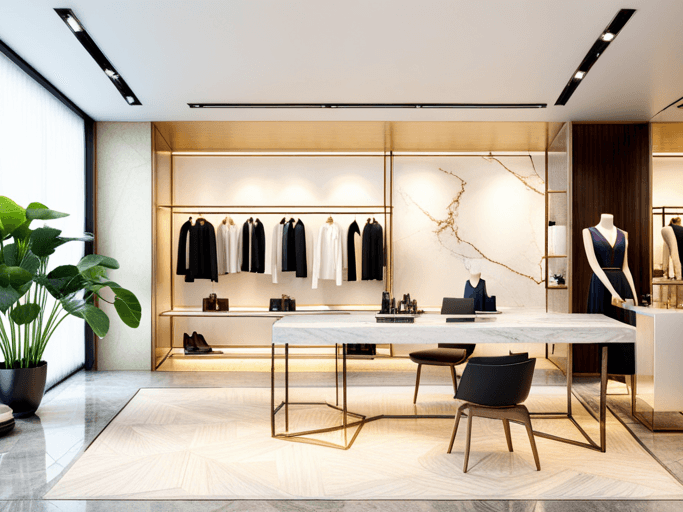Golden Triangle in Store Design: How to make customers buy from you?
Creating the right design for a store requires careful planning and consideration of various factors that can influence the customer experience and sales efficiency. Here are a few steps to help you start the store design process:
1. Define Goals and Target Audience:
Store design development begins with a clear definition of your goals and understanding the target audience. You need to determine the type of store you want to create, whether it's a retail store, specialized boutique, or another format, and consider the unique features of the products or services you offer. Additionally, it's important to research your target audience to understand their preferences, needs, and shopping behavior. Knowing your target audience will allow you to create a store design that effectively attracts and retains them, taking into account their expectations and preferences. The entire store design should align with marketing strategies to create a strong and appealing brand and ensure successful interaction with your target audience.

KPD.design Conceptual Women's Clothing Boutique
2. Store Ergonomics:
Arrange furniture and fixtures in a way that is comfortable and functional for customers. Consider the flow of movement and provide enough space for browsing and trying out products, if applicable. Place comfortable waiting or resting areas, especially if your store offers longer shopping or service experiences.
Ergonomics - a set of principles about the arrangement of objects in space for maximum functionality and convenience for customers. Store ergonomics include aspects such as the proper distance between hangers and the height of tables for displaying merchandise. The distance at which a hanger should hang is determined by customer convenience.

KPD.design Conceptual Women's Clothing Boutique
Ideally, the hanger should be at a height that allows customers to remove and wear clothing without excessive effort. As for the height of the display table, it should be designed to allow staff to arrange products without excessive bending or lowering their position. Typically, the display table is positioned at waist level or slightly below to minimize physical strain on staff and ensure ease of work.
Arrange products in a way that attracts customers' attention and stimulates their purchases. Divide the store into different zones or departments based on types of products or categories. This can be achieved using the triangle rule. This concept proposes an optimal placement of key areas such as the entrance, checkout area, and product display in the form of a triangle. Such placement ensures efficiency and convenience for customers, allowing them to move freely and quickly find the items they need. The golden triangle, including the entrance, checkout, and popular products, is the foundation for an attractive and functional store design.
3. Accent Lighting and General Lighting:
To create an atmosphere and draw attention to products, consider the combination of general lighting and accent lighting. General lighting provides overall brightness in the space, while accent lighting highlights specific products or areas in the store.

KPD.design Designer Clothing Store
When choosing lighting sources, experiment and find the optimal combination. It is important to consider the number of lumens required for sufficient store illumination. The number of lumens depends on the size of the space and its functional zones. Additionally, it's essential to select suitable lamps or spotlights that accentuate the qualities and characteristics of the products, creating an attractive visual impression for visitors.
In the end, proper lighting in the store helps create a pleasant and comfortable atmosphere, emphasize the quality and attractiveness of the products, and enhance the visual impact on customers, leading to successful sales and customer satisfaction.
The brightness of lighting in a store is typically measured in "lux." The recommended lighting range for stores is usually between 750 to 1500 lux. This level of brightness ensures sufficient illumination for products to look attractive and provides good visibility for customers.
However, it's also important to consider specific requirements for certain types of products. For example, a jewelry store or an electronics store may require higher brightness to emphasize the details and quality of items. Meanwhile, a store with soft furniture or textiles might benefit from lower brightness to create a cozier atmosphere.
The ideal lighting brightness in a store can be determined through a professional lighting project, taking into account the specific features of the store, its design, and goals.
4. Color Scheme and Decor:
Consider using colors that promote sales, such as red (attention) or orange (impulsivity), but also take into account that each color can evoke different associations and emotions in customers. Pay attention to color combinations to create a harmonious and attractive atmosphere. Additionally, focus on decorative elements, including showcases, posters, signage, and other details that help emphasize your brand and create a unique style.

KPD.design Conceptual Pop-up Store
5. Branding and Visual Identity:
Branding and visual identity create a recognizable image of the store. They help establish a connection with your brand and make a strong impression on customers.
In the store interior design, include the brand's corporate identity from the company's brand book. This includes the logo, colors, fonts, and graphic elements to visually reinforce and "sign" your company. These elements should be present on the store facade, inside the premises, and on product packaging, if applicable.
Coordinate the store's appearance with other sales channels and your company's advertising. This will create a consistent image and ensure visual identity consistency. Customers should easily recognize your brand in any context.
Ensure that the visual elements related to branding are well-visible and prominently presented in the store. They should create a positive impression and support your company's values. Consistency and coherence in the use of design and brand elements will help establish strong connections with customers and reinforce your visual identity in their perception.

KPD.design Women's Clothing Boutique in Theater Style
6. Showcases and Entrance:
Create attractive and sales-oriented showcases that will catch the attention of passersby and interest them. They should be clean, neat, and well-organized to showcase your products or services. The entrance to the store should also be inviting and welcoming, inviting people inside.

KPD.design Clothing and Accessories Store
8. Music and Atmosphere:
Music and atmosphere can significantly influence the mood of customers and their buying behavior. Develop a suitable background sound that corresponds to your brand and audience. Keep in mind that loud and inappropriate music may deter customers, so choose music carefully. I am sure you will face some difficulties in selecting music on your own. Knowledgeable people have organized a business and solved this problem. The Sber Music service selects soundtracks specifically for your target audience and your store.

KPD.design Monobrand Store
9. Convenience and Accessibility:
Ensure that your store is accessible to all categories of customers, including people with disabilities. Provide ramps, wide passages, and convenient shopping carts or baskets. Additionally, offer sufficient parking spaces and comfortable waiting areas.

KPD.design Designer Clothing Store
10. Customer Feedback:
It is important to consider the opinions and feedback of customers when designing and updating the store's design. Conduct surveys and research to understand which aspects of the store can be improved to increase customer satisfaction and boost sales.

KPD.design Women's Clothing Boutique
Product Organization
A little more about product organization. Surely, you have been in stores with narrow aisles between shelves, where there are no focal points, everything looks the same, just a store filled with products, and the customer has to "dig" and choose without the help of salespeople. The organization of product layout in the store plays an important role in attracting the attention of customers, stimulating sales, and providing convenience in searching and selecting products. You can buy something in the store I mentioned earlier, but will your customer enjoy it, how positively will they evaluate this experience for themselves? Besides the price of the product, there is little to interest the customer in such a store.
It is much more pleasant and effective to set up product sales through design, ergonomics, lighting, colors, etc. Let me focus on product layout. It is important if you want to sell more often, at higher prices, and more. Here are a few principles that will help you organize an effective layout in the store:
-
Attractiveness and Simplicity: Place the most attractive and popular products in the most visible and accessible areas of the store. Ensure easy access to them and use simple and logical layout patterns so that customers can easily orient themselves and find the items they need.
-
Categorization: Divide the store into sections or zones according to product categories, such as clothing, footwear, accessories, etc. Group the products within each category in a way that allows customers to easily compare and choose. For example, organize clothes into groups by type (t-shirts, trousers, etc.) or by style (sportswear, casual wear, etc.).
-
Use Focal Points: Create focal points in the store that draw attention and interest from customers. These can be particularly bright or unique products, promotional offers, or demonstration stands. Place these focal points strategically, making them visible from different angles of the store and leading customers to specific areas.
-
Levels of Display: Utilize different levels of display to create an interesting and dynamic visual experience. Arrange products on shelves, racks, or display cases at different heights. This will add variety and allow certain products to stand out among others.
-
The "Golden Triangle" Rule: When organizing product placement, consider the "golden triangle" principle. This means that products on shelves or stands should be arranged in the form of a triangle, with the most attractive and high-margin items at the top. This will encourage customers to navigate throughout the store, notice a variety of products, and potentially increase sales.
-
Clarity and Convenience: Ensure clarity and convenience in the organization of product placement. Arrange products logically, with clear visibility of prices, sizes, specifications, and other product information. Use clear and informative labels or price tags. Regularly maintain and restock shelves and stands to avoid gaps and empty spaces.
-
Sampling and Demonstration: If applicable, provide customers with the opportunity to sample or try out products before purchase. Create corners or stands for product demonstrations or offer touch-and-feel interaction with items to help customers make purchase decisions.
-
Seasonality and Relevance: Take into account seasonal and current trends when organizing product placement. Adapt the store's design and product layout according to holidays, seasons, or fashion trends. Refresh the layout to attract customer attention and maintain their interest in your products.
-
Analysis and Optimization: Regularly analyze the results of product placement and sales. Pay attention to popular and less popular items, the effectiveness of different layouts and arrangements, and make necessary changes to improve sales and customer satisfaction.
For a free consultation, please FILL OUT THE FORM for feedback.


